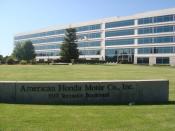The American Honda Motor Company was established as a subsidiary by
Honda in 1959. During the 1960's the type of motorcycles brought by
Americans underwent a major change. Motorcycle registrations increased
by over 800,000 in five years from 1960. In the early 60's the major
competitors were Haley - Davidson of U.S.A, BSA, Triumph and Norton of
the UK and Motto - Guzzi of Italy. Harley-Davidson had the largest
market share with sales in 1959 totalling a6.6 million dollars. Many of
the motorcycles produced were large and bulky and this led to the image
of the motorcycle rider as being one who wore a leather jacket and went
out to cause trouble.
The Boston Consulting Group ( BCG ) report was initiated by the British
government to study the decline in British motorcycle companies around
the world, especially in the USA where sales had dropped from 49% in
1959 to 9% in 1973.
The two key factors the report identified was the
market share loss and profitability declines an the scale economy
disadvantages in technology, distribution, and manufacturing.
The BCG report showed that success of the Japanese manufacturers started
with the growth of their own domestic markets. The high production for
domestic demand led to Honda experiencing economies of scale as the cost
of producing motorbikes declined with the level of output. This provided
Honda to achieve a highly competitive cost position which they used to
penetrate into the US market. " The basic philosophy of the Japanese
manufacture is that high volumes per model provide the potential for
high productivity as a result of using capital intensive and highly
automated techniques. Their marketing strategies are therefore directed
towards developing these high model volumes, hence the careful
attention that we have observed them giving to growth and market
share." (...


